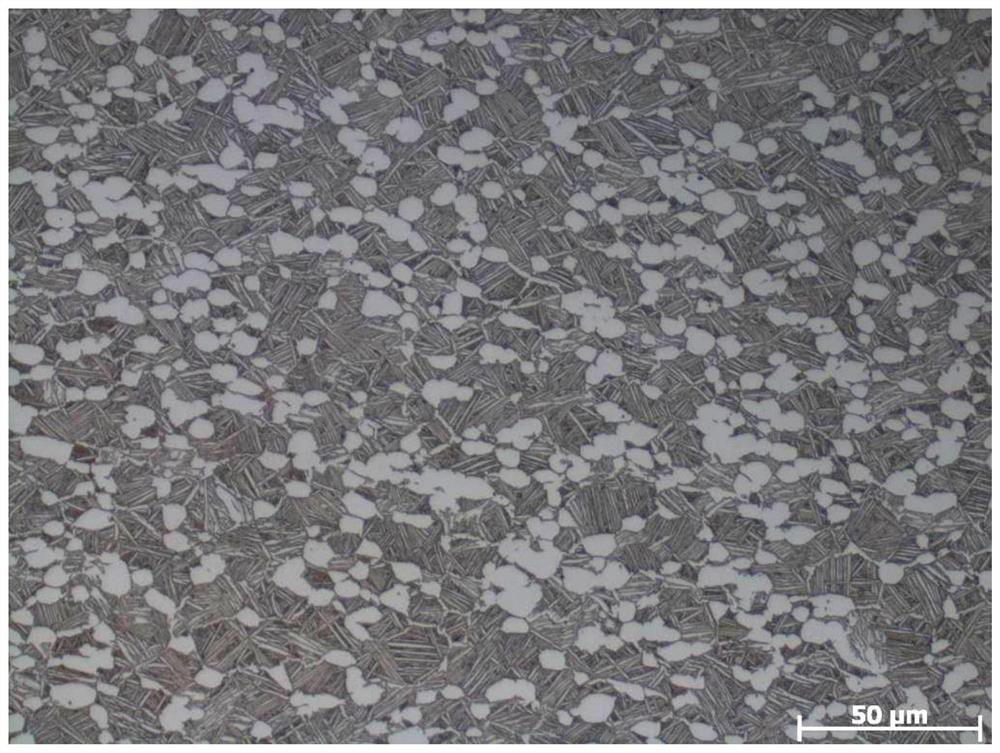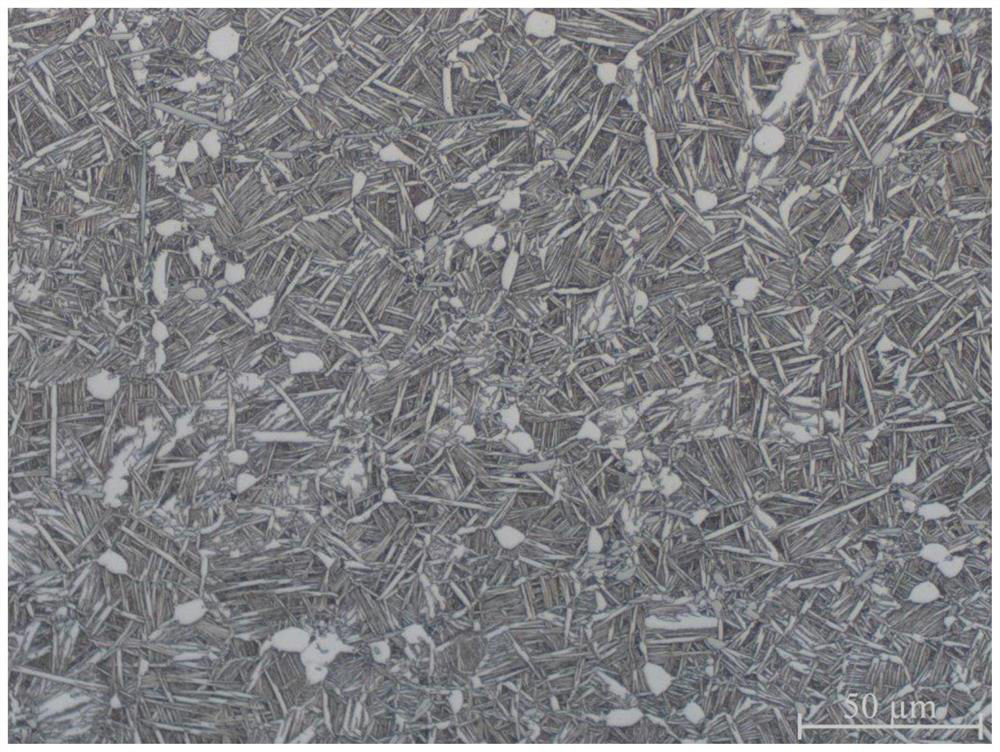High-strength titanium alloy used at temperating being 500-600 DEG C and processing method thereof
A processing method, titanium alloy technology, applied in the field of titanium alloy processing, can solve the problems of poor oxidation resistance, unsatisfactory, and influence on the use of alloys, and achieve the effect of improving plasticity and high temperature oxidation resistance
- Summary
- Abstract
- Description
- Claims
- Application Information
AI Technical Summary
Problems solved by technology
Method used
Image
Examples
Embodiment 1
[0042]A material ingot with a diameter of 400mm was prepared by a smelting method. The β-transition temperature of the alloy ingot detected by the metallographic method was 990°C. The chemical composition of the ingot is listed in Table 2.
[0043]Table 2 Alloy composition in Example 1 (mass percentage, wt.%)
[0044]
[0045]Step 1): The alloy ingot is heated to 1150°C, kept for 24 hours, and then out of the furnace. The upsetting and drawing deformation are completed on a hydraulic press. The forging ratio of the upsetting and drawing is both 2. After forging, air cooling is completed to complete the ingot. The homogenization treatment. Then the ingot is heated to 1015℃, and the upsetting and drawing deformation are carried out for 2 fires. Each fire completes one upsetting and one drawing. The forging ratio of the upsetting and drawing length is both 2. After forging, air cooling is performed to obtain the blooming Of blanks.
[0046]Step 2): The billet obtained in step 1) is heated to 955°C...
Embodiment 2
[0052]A material ingot with a diameter of 380mm was prepared by the smelting method. The β-transition temperature of the alloy ingot detected by the metallographic method was 1000°C. The chemical composition of the ingot is listed in Table 4.
[0053]Table 4 Example 2 Material alloy composition (mass percentage, wt.%)
[0054]
[0055]Step 1): The alloy ingot is heated to 1200°C, kept for 48 hours, and then out of the furnace. The upsetting and drawing deformation are completed on a hydraulic press with a forging ratio of 4 and air cooling after forging to complete the homogenization of the ingot. Then the ingot is heated to 1045℃ and 1025℃ successively, and the upsetting and drawing deformation are carried out for one fire respectively. Each fire completes one upsetting and one drawing, with a forging ratio of 3.8. After forging, it is air-cooled to obtain the blooming Blank.
[0056]Step 2): Heat the billet obtained in step 1) to 960°C, and perform 2 rounds of upsetting and drawing deformatio...
Embodiment 3
[0062]The material ingot with a diameter of 540mm was prepared by the smelting method. The β transformation temperature of the alloy ingot detected by the metallographic method was 1015°C, and the chemical composition of the ingot is listed in Table 6.
[0063]Table 6 Example 3 Material alloy composition (mass percentage, wt.%)
[0064]
[0065]Step 1): The alloy ingot is heated to 1200°C, kept for 20 hours, and then out of the furnace. The upsetting and drawing deformation are completed on the hydraulic press. The forging ratio per fire is 4, and the ingot is air cooled after forging to complete the homogenization of the ingot. deal with. Then the ingot is heated to 1040°C, two upsetting and two drawing are completed, and the total forging ratio of each fire is 3.8. After forging, it is air-cooled to obtain a billet after blooming.
[0066]Step 2): Heat the blank obtained in step 1) to 985°C, and perform upsetting and drawing deformation for 3 times on a hydraulic press. Each fire completes on...
PUM
| Property | Measurement | Unit |
|---|---|---|
| Diameter | aaaaa | aaaaa |
| Diameter | aaaaa | aaaaa |
| Diameter | aaaaa | aaaaa |
Abstract
Description
Claims
Application Information
 Login to View More
Login to View More - R&D
- Intellectual Property
- Life Sciences
- Materials
- Tech Scout
- Unparalleled Data Quality
- Higher Quality Content
- 60% Fewer Hallucinations
Browse by: Latest US Patents, China's latest patents, Technical Efficacy Thesaurus, Application Domain, Technology Topic, Popular Technical Reports.
© 2025 PatSnap. All rights reserved.Legal|Privacy policy|Modern Slavery Act Transparency Statement|Sitemap|About US| Contact US: help@patsnap.com



